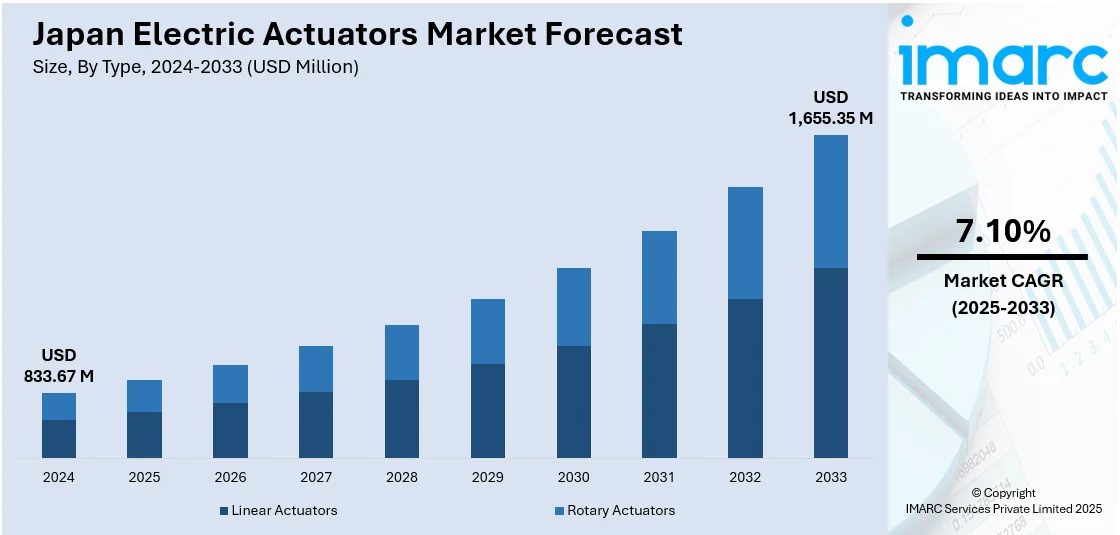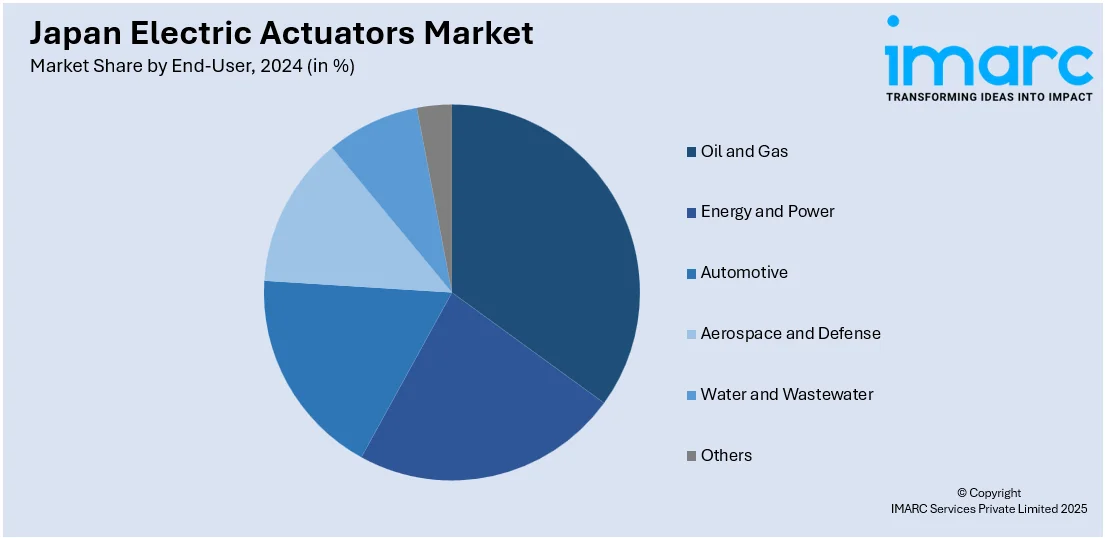
Japan Electric Actuators Market Size, Share, Trends and Forecast by Type, End-User, and Region, 2025-2033
Japan Electric Actuators Market Overview:
The Japan electric actuators market size reached USD 833.67 Million in 2024. Looking forward, IMARC Group expects the market to reach USD 1,655.35 Million by 2033, exhibiting a growth rate (CAGR) of 7.10% during 2025-2033. The growing demand for consumer electronics is creating the need for reliable and efficient motion control in manufacturing processes. Besides this, the rising adoption of smart home technologies that enhance comfort and accessibility for older adults is contributing to the expansion of the Japan electric actuators market share.
|
Report Attribute
|
Key Statistics
|
|---|---|
|
Base Year
|
2024 |
|
Forecast Years
|
2025-2033
|
|
Historical Years
|
2019-2024
|
| Market Size in 2024 | USD 833.67 Million |
| Market Forecast in 2033 | USD 1,655.35 Million |
| Market Growth Rate 2025-2033 | 7.10% |
Japan Electric Actuators Market Trends:
Increasing demand for consumer electronics
Rising demand for consumer electronics is positively influencing the market. According to industry reports, the consumer electronics segment in Japan registered the market value of USD 5,955.06 Million in 2024. As people are seeking advanced devices, such as smartphones, tablets, and wearable tech, electronics manufacturers are expanding their production capacities and investing in high-precision automation systems. Electric actuators are essential components in these systems, as they enable accurate positioning, smooth movement, and energy-efficient operation of machinery used in tasks like assembly, testing, and packaging. With electronics becoming more complex, manufacturers are increasingly relying on actuators that offer fine control and repeatability. Additionally, electric actuators support cleanroom environments by producing less noise and no emissions, making them ideal for sensitive electronic manufacturing. In sectors, such as semiconductor fabrication, actuators help maintain the high level of accuracy required in wafer handling and chip manufacturing. As Japan continues to innovate in consumer electronics, robotics, and smart devices, the need for advanced manufacturing tools is growing. This is driving the demand for electric actuators that support faster production speeds and higher product quality. The shift towards automation, miniaturization, and energy optimization in electronics is strengthening the market, making it a critical part of the evolving industrial and technological landscape in Japan.

Growing aging population
The increasing aging population is impelling the Japan electric actuators market growth. The Tokyo-based National Institute of Population and Social Security Research anticipated that by 2040, 34.8% of Japan's population will be elderly individuals. As the workforce is shrinking, industries are turning to automation to maintain productivity and reduce dependency on manual labor. Electric actuators play an important role in automated systems by controlling motion in machines, robots, and equipment with high precision and efficiency. In healthcare, the growing elderly population is leading to a higher demand for advanced medical devices, such as electric beds, mobility aids, and surgical tools, which employ electric actuators for smooth and safe movement. In residential settings, electric actuators support smart home technologies that enhance comfort and accessibility for older adults, including adjustable furniture, automated doors, and window systems. In public infrastructure, age-friendly solutions like automated transport systems and elevators also rely on electric actuators. As aging is becoming a long-term trend in Japan, the need for reliable, energy-efficient, and low-maintenance actuators continues to increase.
Japan Electric Actuators Market Segmentation:
IMARC Group provides an analysis of the key trends in each segment of the market, along with forecasts at the country and regional levels for 2025-2033. Our report has categorized the market based on type and end-user.
Type Insights:
- Linear Actuators
- Rotary Actuators
The report has provided a detailed breakup and analysis of the market based on the type. This includes linear actuators and rotary actuators.
End-User Insights:

- Oil and Gas
- Energy and Power
- Automotive
- Aerospace and Defense
- Water and Wastewater
- Others
A detailed breakup and analysis of the market based on the end-user have also been provided in the report. This includes oil and gas, energy and power, automotive, aerospace and defense, water and wastewater, and others.
Regional Insights:
- Kanto Region
- Kansai/Kinki Region
- Central/ Chubu Region
- Kyushu-Okinawa Region
- Tohoku Region
- Chugoku Region
- Hokkaido Region
- Shikoku Region
The report has also provided a comprehensive analysis of all the major regional markets, which include Kanto Region, Kansai/Kinki Region, Central/Chubu Region, Kyushu-Okinawa Region, Tohoku Region, Chugoku Region, Hokkaido Region, and Shikoku Region.
Competitive Landscape:
The market research report has also provided a comprehensive analysis of the competitive landscape. Competitive analysis such as market structure, key player positioning, top winning strategies, competitive dashboard, and company evaluation quadrant has been covered in the report. Also, detailed profiles of all major companies have been provided.
Japan Electric Actuators Market News:
- In February 2025, a research team from the University of Tokyo and Waseda University revealed that they created the biggest ‘biohybrid’, featuring components constructed from cultivated human tissue. The main breakthrough was the team’s newly created multiple muscle tissue actuator, a high-efficiency muscle configuration formed by grouping very thin strands of cultured human tissue into a sushi roll shape to function as a single larger muscle.
- In July 2024, Yamaha Motor Company created the innovative Yamaha Automated Manual Transmission (Y-AMT), which could automate a motorcycle's clutch and gear-changing functions during initial acceleration and while in motion through advanced electronic control. This was set to be included in the MT-09 Y-AMT, which was expected to launch in Japan by year’s end. During gear changes, the engine control unit (ECU) and the motor control unit (MCU) oversaw the actuators interact and synchronize with one another.
Japan Electric Actuators Market Report Coverage:
| Report Features | Details |
|---|---|
| Base Year of the Analysis | 2024 |
| Historical Period | 2019-2024 |
| Forecast Period | 2025-2033 |
| Units | Million USD |
| Scope of the Report |
Exploration of Historical Trends and Market Outlook, Industry Catalysts and Challenges, Segment-Wise Historical and Future Market Assessment:
|
| Types Covered | Linear Actuators, Rotary Actuators |
| End-Users Covered | Oil and Gas, Energy and Power, Automotive, Aerospace and Defense, Water and Wastewater, Others |
| Regions Covered | Kanto Region, Kansai/Kinki Region, Central/Chubu Region, Kyushu-Okinawa Region, Tohoku Region, Chugoku Region, Hokkaido Region, Shikoku Region |
| Customization Scope | 10% Free Customization |
| Post-Sale Analyst Support | 10-12 Weeks |
| Delivery Format | PDF and Excel through Email (We can also provide the editable version of the report in PPT/Word format on special request) |
Key Questions Answered in This Report:
- How has the Japan electric actuators market performed so far and how will it perform in the coming years?
- What is the breakup of the Japan electric actuators market on the basis of type?
- What is the breakup of the Japan electric actuators market on the basis of end-user?
- What is the breakup of the Japan electric actuators market on the basis of region?
- What are the various stages in the value chain of the Japan electric actuators market?
- What are the key driving factors and challenges in the Japan electric actuators market?
- What is the structure of the Japan electric actuators market and who are the key players?
- What is the degree of competition in the Japan electric actuators market?
Key Benefits for Stakeholders:
- IMARC’s industry report offers a comprehensive quantitative analysis of various market segments, historical and current market trends, market forecasts, and dynamics of the Japan electric actuators market from 2019-2033.
- The research report provides the latest information on the market drivers, challenges, and opportunities in the Japan electric actuators market.
- Porter's five forces analysis assist stakeholders in assessing the impact of new entrants, competitive rivalry, supplier power, buyer power, and the threat of substitution. It helps stakeholders to analyze the level of competition within the Japan electric actuators industry and its attractiveness.
- Competitive landscape allows stakeholders to understand their competitive environment and provides an insight into the current positions of key players in the market.
Need more help?
- Speak to our experienced analysts for insights on the current market scenarios.
- Include additional segments and countries to customize the report as per your requirement.
- Gain an unparalleled competitive advantage in your domain by understanding how to utilize the report and positively impacting your operations and revenue.
- For further assistance, please connect with our analysts.
 Request Customization
Request Customization
 Speak to an Analyst
Speak to an Analyst
 Request Brochure
Request Brochure
 Inquire Before Buying
Inquire Before Buying




.webp)




.webp)












